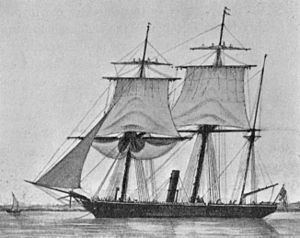Name HMS Sparrowhawk Laid down 6 August 1855 Fate Sold in 1872 Launched 9 February 1856 Displacement 780,200 kg | Ordered 26 July 1855 Completed By 7 April 1856 Construction started 6 August 1855 Weight 873.8 tons | |
 | ||
Builder Young, Magnay & Co., LimehouseEngines by Humphrys, Tennant & Dykes | ||
HMS Sparrowhawk was a Vigilant-class second-class despatch/gunvessel launched on 9 February 1856 at Limehouse, England and served at various stations in the Far East. By the spring of 1865, her rig was a converted to that of a three-masted barque. She was sold in 1872 and was eventually lost in a typhoon.
Contents
Design
Her class were designed as second-class despatch and gunvessels. They were intended to operate close inshore during the Crimean War and were essentially enlarged versions of the Arrow-class gunvessel, which has been designed by the Surveyor’s Department in 1854.
Propulsion
A two-cylinder horizontal single expansion steam engine by Humphrys, Tennant and Dykes provided 726 indicated horsepower (541 kW) through a single screw, and gave a top speed of about 11 knots.
Sail plan
All Vigilant-class gunvessels were barque-rigged.
Armament
Although designed with a pair of 68-pounder Lancaster muzzle-loading rifles, the Vigilant class were finished with one 7-inch (180 mm)/110-pound (50 kg) Armstrong breech-loading gun, one 68-pound (31 kg) Lancaster muzzle-loading rifled gun and two 20-pounder breech loaders.
Service history
Porcher Island, near Prince Rupert, British Columbia, is named after Edwin Augustus Porcher (1821–1878), who served as captain of HMS Sparrowhawk at Esquimalt Naval Base, Vancouver Island, from the spring of 1865 until he returned to England in autumn 1868. While serving with the North Pacific Squadron, Commander Porcher made four summertime voyages to the North Coast of British Columbia; in 1866, 1867 and twice in 1868.
